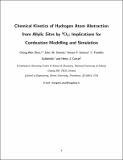| dc.contributor.author | Zhou, Chong-Wen | |
| dc.contributor.author | Simmie, John M. | |
| dc.contributor.author | Somers, Kieran | |
| dc.contributor.author | Goldsmith, C. Franklin | |
| dc.contributor.author | Curran, Henry J. | |
| dc.date.accessioned | 2017-10-05T11:58:50Z | |
| dc.date.issued | 2017-02-14 | |
| dc.identifier.citation | Zhou, Chong-Wen, Simmie, John M., Somers, Kieran P., Goldsmith, C. Franklin, & Curran, Henry J. (2017). Chemical Kinetics of Hydrogen Atom Abstraction from Allylic Sites by 3O2; Implications for Combustion Modeling and Simulation. The Journal of Physical Chemistry A, 121(9), 1890-1899. doi: 10.1021/acs.jpca.6b12144 | en_IE |
| dc.identifier.issn | 1520-5215 | |
| dc.identifier.uri | http://hdl.handle.net/10379/6866 | |
| dc.description.abstract | ABSTRACT: Hydrogen atom abstraction from allylic C−H bonds by molecular
oxygen plays a very important role in determining the reactivity of fuel molecules
having allylic hydrogen atoms. Rate constants for hydrogen atom abstraction by
molecular oxygen from molecules with allylic sites have been calculated. A series of
molecules with primary, secondary, tertiary, and super secondary allylic hydrogen
atoms of alkene, furan, and alkylbenzene families are taken into consideration.
Those molecules include propene, 2-butene, isobutene, 2-methylfuran, and toluene
containing the primary allylic hydrogen atom; 1-butene, 1-pentene, 2-ethylfuran,
ethylbenzene, and n-propylbenzene containing the secondary allylic hydrogen atom;
3-methyl-1-butene, 2-isopropylfuran, and isopropylbenzene containing tertiary
allylic hydrogen atom; and 1−4-pentadiene containing super allylic secondary hydrogen atoms. The M06-2X/6-311++G(d,p)
level of theory was used to optimize the geometries of all of the reactants, transition states, products and also the hinder rotation
treatments for lower frequency modes. The G4 level of theory was used to calculate the electronic single point energies for those
species to determine the 0 K barriers to reaction. Conventional transition state theory with Eckart tunnelling corrections was
used to calculate the rate constants. The comparison between our calculated rate constants with the available experimental results
from the literature shows good agreement for the reactions of propene and isobutene with molecular oxygen. The rate constant
for toluene with O2 is about an order magnitude slower than that experimentally derived from a comprehensive model proposed
by Oehlschlaeger and coauthors. The results clearly indicate the need for a more detailed investigation of the combustion kinetics
of toluene oxidation and its key pyrolysis and oxidation intermediates. Despite this, our computed barriers and rate constants
retain an important internal consistency. Rate constants calculated in this work have also been used in predicting the reactivity of
the target fuels of 1-butene, 2-butene, isobutene, 2-methylfuran, 2,5-dimethylfuran, and toluene, and the results show that the
ignition delay times for those fuels have been increased by a factor of 1.5−3. This work provides a first systematic study of one of
the key initiation reaction for compounds containing allylic hydrogen atoms. | en_IE |
| dc.description.sponsorship | We appreciate the support from Saudi Aramco under the
FUELCOM program. The Irish Centre for High-End
Computing, ICHEC, is thanked for the provision of computational
resources. C.F.G. gratefully acknowledges financial
support from Brown University. | en_IE |
| dc.format | application/pdf | en_IE |
| dc.language.iso | en | en_IE |
| dc.publisher | American Chemical Society | en_IE |
| dc.relation.ispartof | J. Phys. Chem. A. | en |
| dc.rights | Attribution-NonCommercial-NoDerivs 3.0 Ireland | |
| dc.rights.uri | https://creativecommons.org/licenses/by-nc-nd/3.0/ie/ | |
| dc.subject | Chemistry | en_IE |
| dc.subject | Chemical kinetics | en_IE |
| dc.subject | Hydrogen atom abstraction | en_IE |
| dc.subject | Allylic sites | en_IE |
| dc.subject | Combustion modeling | en_IE |
| dc.subject | Combustion simulation | en_IE |
| dc.title | Chemical kinetics of hydrogen atom abstraction from allylic sites by 3O2; Implications for combustion modelling and simulation | en_IE |
| dc.type | Article | en_IE |
| dc.date.updated | 2017-10-03T07:48:10Z | |
| dc.identifier.doi | 10.1021/acs.jpca.6b12144 | |
| dc.local.publishedsource | http://dx.doi.org/10.1021/acs.jpca.6b12144 | en_IE |
| dc.description.peer-reviewed | peer-reviewed | |
| dc.contributor.funder | Saudi Aramco | |
| dc.description.embargo | 2018-02-14 | |
| dc.internal.rssid | 12486524 | |
| dc.local.contact | Henry Curran, Dept Of Chemistry, Room 215, Arts/Science Building, Nui Galway. 3856 Email: henry.curran@nuigalway.ie | |
| dc.local.copyrightchecked | Yes | |
| dc.local.version | SUBMITTED | |
| nui.item.downloads | 366 | |


